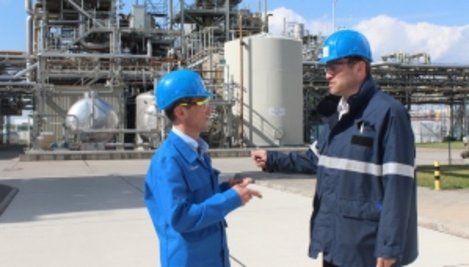AkzoNobel is part of a profitable value chain at the chemical park

Chemical and competence network at the Bitterfeld-Wolfen site
“Chlorine should be produced where it is used”, says Stefan Kauerauf, plant manager of the Dutch AkzoNobel Group at the chemical park known as Chemical Park of Bitterfeld-Wolfen in the south of the German federal state of Saxony-Anhalt. The company with 70 employees operates a chlor-alkali electrolysis plant based on the membrane process as well as plants for production of hydrogen chloride, hydrochloric acid and sodium hypochlorite. The plant is not only located in the middle of important consumers of chlorine, sodium hydroxide and hydrogen, but it also recovers starting materials for its own production from them. The more than 18-kilometre long pipeline bridge network in the industrial area creates a chemical network that mostly frees associated companies from complex logistical activities and increases their efficiency. “For us, the chemical park with its excellent infrastructure is something like the package tour with all-round carefree package in the tourism industry”, says Kauerauf. This expertise is a tradition: Saxony-Anhalt is the birthplace of the chemical park concept and is today among the most important chemical centres in Europe with a total of five chemical industrial parks.
The Dutch investor AkzoNobel was attracted to the Bitterfeld-Wolfen site by what already attracted pioneers of chlorine chemistry as they put the first industrial chlorine electrolysis plant into operation in 1894: there were a lot of free areas, manpower as well as the raw material salt and the energy source brown coal. When the Dutch company initially took over Bitterfelder Chlor-Alkali GmbH as ECI Elektro-Chemie GmbH Ibbenbüren in a joint venture with Preussag AG in 1997, there were already many redeveloped areas in the chemical park, including a developed network of roads, rails and pipelines, qualified specialists, a pipeline which transported sodium chloride from the city of Bernburg to the chemical park, and a branched pipeline totalling about 150 kilometres in length through which Linde AG sent hydrogen to industrial customers in the region.
In the course of profiling the Preussag conglomerate into the TUI tourism group, in 2002 the Dutch group took over its share in the joint venture and reconfigured the company as AkzoNobel Industrial Chemicals GmbH. “We are part of a value-added chain which serves attractive market segments with innovative products”, emphasises Stefan Kauerauf. For example, AkzoNobel supplies Evonik Industries with hydrogen chloride in the chemical network. Evonik requires the basic material for the production of silicon tetrachloride, which is in turn supplied to Heraeus by means of a pipeline. The German technology group’s Bitterfeld plant uses this to produce high-purity fused silica for optical fibres. In turn, by-products are returned to AkzoNobel in a completely self-contained cycle of chlorine materials.
“Thanks to the tradition of the chemical industry in this region, the industry encounters a high degree of acceptance among the population”, emphasises Kauerauf. In the public authorities there are also many employees with solid expertise in chemistry, so approval procedures would be handled competently and quickly. Kauerauf sees the nearby university and research environment with the Anhalt University of Applied Sciences in Köthen, the Martin Luther University of Halle-Wittenberg, Fraunhofer Institute for Mechanics of Materials IWM and the Fraunhofer Center for Silicon Photovoltaics CSP as another asset for the location. Obtaining well-trained specialists also turns out to be more difficult for AkzoNobel due to the decreased numbers of school graduates, but in cooperation with the German Chemical Industry Association (VCI), emphasis is being placed to get girls and boys interested in chemistry at an early stage. Kauerauf mentions the experimental competition “Chemkids”, the financial support of schools in order to provide better equipment for chemistry lessons or action days on the subject of training.
The plant manager sees a major challenge in energy transition. Affordable energy, economisation and efficiency are essential for survival of the energy-intensive chemical industry. Kauerauf sees the future in the further development of renewable energies which are abundantly produced around ChemiePark Bitterfeld-Wolfen. The vision of the model region for hydrogen in Central Germany becomes tangible with the Central German research alliance “HYPOS”. Wind and solar power not capable of being stored shall be transformed into hydrogen, an energy source that is capable of being stored through chemical processes. “Thanks to an efficient chemical industry and the caverns available here for storing hydrogen, the region provides the best prerequisites for this”, says Stefan Kauerauf.
